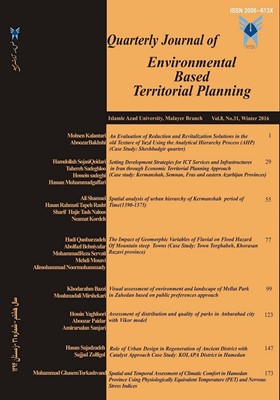Spatial analysis of urban hierarchy of Kermanshah period of time(1390-1375 )
Subject Areas :Ali Shamaei 1 , Hasan Rahmati Tapeh Rasht 2 , Sharif Hajie Tash Naloos 3 , Neamat Kordeh 4
1 - Ph.D. Assistant Professor, Department of Geography, Kharazmi University, Tehran, IRAN
2 - MA., Student in urban planning, Kharazmi University, Tehran, IRAN
3 - MA., Student in urban planning, Kharazmi University, Tehran, IRAN
4 - MA., Student in urban planning, Kharazmi University, Tehran, IRAN
Keywords: GIS, Kermanshah, Spatial analysis, urbanhierarchicalsystem, firstcity,
Abstract :
This study analyzes the spatial variations of urban hierarchy of Kermanshah province in the period of 1996-2011. This study aimed to explain the uneven distribution of population and social inequality-to reduce the economic disparities across the province. Analysis indicates that 29 cities of Kermanshah in 2011, with a population of about 851,405 people in the city of Kermanshah Province, 62.8% of the urban population ,approximately 16 times and 8times the second and third cities of the same province (Kangavar) population has the most unevenly distributed population. In fact, the lack of central cities in metropolitan networks in urban areas has created instability. This analytic method utilizing GIS, EXCEL, the rank-size model of a class difference, Entropy Coefficient and Lorenz Curve has been done. Results of the entire hierarchy of methods used in urban imbalance and instability tends to show instabilities. Based on a floor equal to 96.6 percent in 2011, more than 141 thousands of people in equations obtained from the following cities ranked as the cities of Kermanshah show much difference between the three periods and the line of normality. The entropy rate of 75 year /8to / 79 in 85 and in year 2011 ، /69 which indicates heterogeneity in the distribution of population was reached. The city of Kermanshah in terms of spatial distribution of population is the worst compared to other cities , so that, the first city ( Kermanshah ) has 216 times more population compared to the second city ( Kvzran ).
1- آسایش، حسین و مشیری ، سید رحیم (1371): روش شناسی و تکنیک های علمی در علوم انسانی با تاکید بر جغرافیا، تهران نشر قومس
2- بردی آنا مراد نژاد، رحیم (1390)؛ بررسی تحلیل سلسله مراتب شهری در استان کردستان ، فصلنامه علمی پژوهشی جغرافیای انسانی، سال سوم، شماره دوم
3- بهفروز، فاطمه(1374): زمینه های غالب در جغرافیای انسانی، انتشارات دانشگاه تهران چاپ اول
4- تقوایی، مسعود و رضایی، مریم(1389): تحلیل جغرافیایی بر شبکه شهری استان ایلام با تاکید بر نقش شهر های کوچک، نشریه علمی پژوهشی جغرافیا و برنامه ریزی دانشگاه تبریز ، سال 15 ،شماره 32
5- تقوایی، مسعود و صابری حمید (1389): تحلیلی بر سیستم های شهری ایران طی سالهای 1335 تا 1385 مطالعات و پژوهشهای شهری منطقه ای ، شماره پنجم
6- تولایی، سیمین و خزایی، ام البنین(1385): الگوی توزیع فضایی جمعیت در نظام شهری استان مازندران 1355 تا 1385 نشریه ی علمی پژوهشی انجمن جغرافیای ایران، سال چهارم
7- جلالی، محسن(1387): بررسی و برآوردهای ضریب جینی در ایران، فصلنامه پژوهشهای اقتصادی ایران، شماره36
8- حاجی پور، خلیل و زبر دست، اسفندیار(1384): بررسی تحلیل و ارائه الگویی برای نظام شهری استان خوزستان ،نشریه ی هنرهای زیبا شماره 23
9- حکمت نیا، حسن و موسوی، میرنجف(1385): کاربرد مدل در برنامه ریزی شهری و ناحیه ای، انتشارات علم نوین، چاپ اول یزد
10- رهنمایی، محمد تقی و ابراهیم پوراحد(1390): سیر تحولات نخست شهری و نظام شهری منطقه آذربایجان 1335 تا 1385 فصلنامه آمایش سرزمین، سال سوم ، شماره پنجم
11- زبردست، اسفندیار (1386): بررسی تحولات نخست شهری در ایران، نشریه ی هنرهای زیبا: شماره 29
12- زنجانی، حبیب اله(1371): جمعیت و توسعه، چاپ اول تهران انتشارات مرکز مطالعات و تحقیقات شهرسازی و معماری ایران
13- شکویی، حسین(1373): دیدگاههای نو در جغرافیای شهری، جلد اول، چاپ سوم تهران، انتشارات سمت
14- عابدین درکوش، سعید(1380): درآمدی براقتصاد شهری، مرکز نشر جهاد دانشگاهی، چاپ دوم
15- عظیمی، ناصر (1381): پویش شهرنشینی و مبانی نظام شهری ، چاپ اول، مشهد نشر نیک
16- فرید، یدالله(1368): جغرافیا و شهر شناسی، چاپ اول : انتشارات دانشگاه تبریز
17- مرکز آمار ایران، سالنامه آماری سالهای 75 و 85 استان کرمانشاه
18- مرکز آمار ایران، نتایج تفصیلی سرشماری عمومی نفوس و مسکن(استان کرمانشاه سالهای 1375 تا1390)
19- مومنی، منصور(1387): مباحث نوین تحقیق در عملیات، انتشارات دانشگاه تهران
20- نظریان، اصغر(1385): جغرافیای شهری ایران، تهران؛ انتشارات دانشگاه پیام نور
21- نسترن، مهین و ایزدی، ملیحه(1389): تحلیل سلسله مراتبی شهری در شهرهای بالای صد هزار نفر کشور ؛ فصلنامه جغرافیایی آمایش محیط ،شماره 11
22- هوشیار، حسن(1388): ارزیابی سلسله مراتبی شهری استان آذربایجان غربی در دوره زمانی 1335 تا1385 ؛ فصلنامه علمی پژوهشی جغرافیا و برنامه ریزی دانشگاه تبریز ، سال 14، شماره 30
23- AL-Hathloul،s.and N.Edadan(forth coming1997):the distribution and growth of urban settlmentsin Saudi Arabia;journal of social studies;special issue on center-peri phery relation in the middle east.
24- Chen;yang vang;(2008):A wave-spectrum analysis of urban population density:Entrpy;Fractal.
25- Clarc;D.(2000);urbanworld;Globalcity;Rovtled;London.
26- Esparza;A(2005);The spatial markets of cities oaganized in a hievar chical system; Cambridge university press.
27- Frunkin; Norman; (2006): Guide to Economicin ;publisher;M.E.Sharpe.
28- Caves;Rogerw;(2005):Encyclopedia of the city.first published by Routledge.
29- Nitsch;Volker;(2005):zipf zipped;Journal of urban Economics ;No.57;www.elseviev.com
30- Sassen;S(2006);TheGlobalcity;NewYork;London;Tokyo;Princeton niversity press.
31- Schulter;Christian and Trede;mark;(2009);Tailsof Lorenz curvev Journal of Econometrics.No.109


